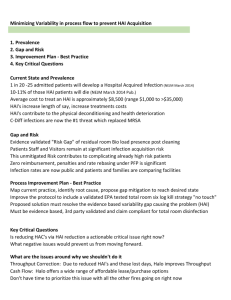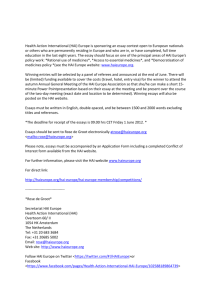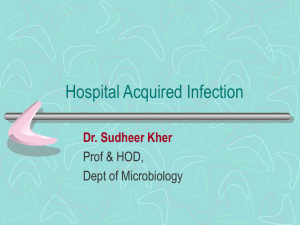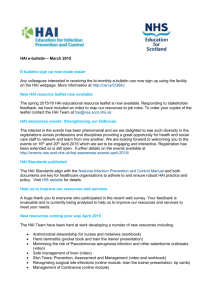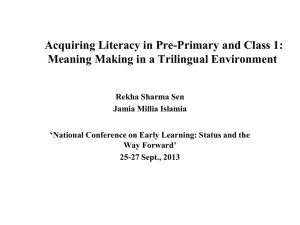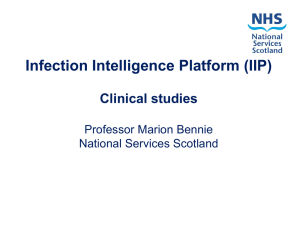AL presentation 13112014
advertisement
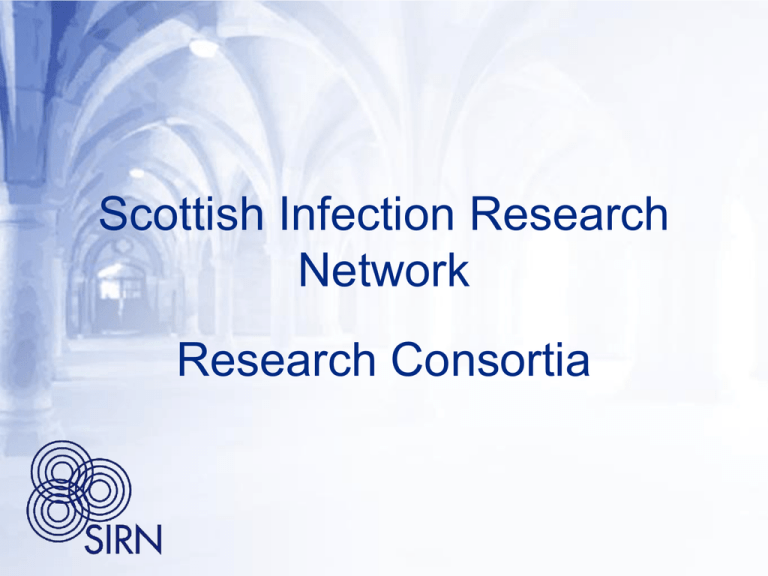
Scottish Infection Research Network Research Consortia Background • • • • • • • • HAI costs £183M annually Occurs in 5% of the acute hospital population Major priority policy area for SGHD (VOL etc) SIRN formed 2006 £200K in 2011 for HAI research £2M to support Scottish HAI research in 2012 £4M Consortia grant 2013. Open ended funding. Need for a 'step change" from individual project focused to a "themed" consortium approach Biosciences National HAI Institute? Informatics Behavioural science (Practice based interventions) Consortium • A National consortium • Translational • Developing, concentrating on 3 areas Informatics (eHealth investment) Science (Omics) Practice based interventions • Based on 9 key priority areas identified by SGHD SGHD key priorities • Informatics-based approaches and economic evaluation. • Antibiotic resistance and the public health threat posed by antimicrobial resistance. • The role of screening for MRSA, MSSA (and other organisms of potential concern: VRE, NDM-1 etc) and decolonisation in reducing HAI. • Point of care testing and new diagnostic methods that allow for the identification of infection. • Infections within high risk areas and methods of infection prevention. • Emerging pathogens and alert organisms including Enterobacteriaceae bacteraemias, MRSA, MSSA, C difficile, Norovirus. • Barriers to the implementation of Standard Infection Control Precautions/ behavioural research. • Research to support evidence based standard infection control precautions. • Decontamination of equipment, endoscopes and the environment including water quality. Consortium Call • Call October 2013 • December deadline • 4 proposals: 3 progressed to form one combined group • Award December 2014 Scottish Healthcare Associated Infection Prevention Institute (SHAIPI) Strategic vision To become an internationally recognised Institute for excellence in HAI Research utilising 1.Rapid knowledge transfer 2.State of the art laboratory techniques 3.Informatics 4.Novel interventions 5.Optimising evidence for existing interventions and compliance with these To tackle the threat to public health from emergent HAI and antimicrobial resistance for patient benefit in a co-ordinated fashion SHAIPI 19 CoIs, 5 HEIs ( Glasgow University (genomics, informatics); Glasgow Caledonian University (applied infection prevention, patient experience); Strathclyde University (clinical informatics, statistics), Dundee University (informatics, pharmacology), St Andrews University (genomics,informatics) 3 HBs Grampian, Tayside, Fife Strategic partners working with this consortium include: PHI: epidemiology and access to European network of 28 countries Farr institute: access to UK health informatics research network, health policy advice IPS: Infection control practitioners and potential for CARC capacity building in Scotland through internships and international partnerships through the Society HENs (Health economics network): developing health economic analysis of interventions SMVN (Scottish Microbiology and Virology Network): microbiology samples, isolates and laboratory data SICSAG (Scottish Intensive Care Society Audit group) and Scottish Critical Care Trials Group: provide a network to develop a National clinical dataset, identify and trial interventions. Scottish Reference laboratories: organism specific expertise, national collections and datasets SAPG (Scottish Antimicrobial Prescribing Group): focussed on optimising prescribing practice and reducing antimicrobial resistance. Sanger Centre Years 1 and 2: Laying the Foundations • • • • • • Develop an understanding of the epidemiology of the key organisms causing HAI in Scotland. Delivery of national linked data from National datasets; SMR, PIS, ECOSS, NRS by PHI/IIP Enhanced IIP databases in Tayside/Fife/Greater Glasgow and Clyde Health Boards including hospital clinical and laboratory data Phase 1 risk modelling using existing IIP national data providing initial risk estimates for being a case and risk modelling for the outcome of cases for C.difficile, S.aureus and E.coli Evidence for standard infection control precautions: hand hygiene and glove use. Evidence for transmission based precautions : risk assessment, screening and isolation Years 3 to 5: Patient centred outputs • • • • • • • Provide a responsive typing facility that will be used for outbreak control Development of typing tools to support and interpret IC intervention practices within the Hospital setting Understanding the effect of targeted interventions on the epidemiology of causative HAI organisms and how such knowledge can be used for focussed patient management Phase 2 risk modelling highlighting patients at highest risk of HAI. Integration of risk models in service delivery, for patient benefit, through translation of research into IIP by PHI. Risk estimates of E.coli / S.aureus outcomes in infected patients as a direct result of strain identification. These will be used to developing targeted interventions (evidence based, behavioural based and cost effective) for optimising infection prevention and control Evidence of the patient experience and acceptability of IPC related interventions • • • • • • • • • • Wider Deliverables at the end of the Consortium programme Strengthened HAI translational applied research capacity within Scotland via development of researchers at various career stages Improved capacity to capture externally funded research grants Produce REF 2020 returnable research outputs of 3 and 4 star Translate research into learning opportunities for under-and postgraduate students and NHS practitioners Build international research reputation and collaboration in HAI To translate findings from basic science research into clinical practice To demonstrate impact on public health by economic and social benefits of reducing HAI Influence SGHSCD policy to implement safe, effective, patient centred clinical practice related to key HAI and emerging antimicrobial resistance (AMR) European and international collaboration in world leading research Interconnections of Workstreams Feedback loop for WS1,2&3 Example of Patient Analysis Pathway Patient with UTI CHI identification SMR1 ECOSS Data linkage nRTS High resolution typing AMR genotyping Analytic platform Risk modelling Validated models E. coli Targeted IPC Interventions SICPs/TBPs evidence for generic Interventions Targeted prevention and Management Evaluation of Patient and practitioner Experience FIN
